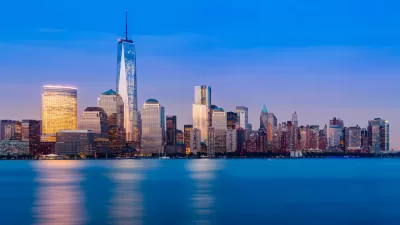New York Times Architecture Critic Michael Kimmelman unequivocally pans the newly opened 1 World Trade Center as a cautionary tale: "The point is that something better was possible in Lower Manhattan."
The paper of record has released its architectural review of one of the most eagerly anticipated buildings in American history. To put it mildly, Michael Kimmelman is not a fan of the tallest building in North America. A sampling of his critiques:
- "Like the corporate campus and plaza it shares, 1 World Trade speaks volumes about political opportunism, outmoded thinking and upside-down urban priorities. It’s what happens when a commercial developer is pretty much handed the keys to the castle. Tourists will soon flock to the top of the building, and tenants will fill it up. But a skyscraper doesn’t just occupy its own plot of land. Even a tower with an outsize claim on the civic soul needs to be more than tall and shiny."
- "Replacing the twin towers with another giant office building was somehow supposed to show New York’s indomitable spirit: the defiant city transfigured from the ashes. To the contrary, 1 World Trade implies (wrongly) a metropolis bereft of fresh ideas. It looks as if it could be anywhere, which New York isn’t."
- "Stripped of prospective cultural institutions, as well as of street life and housing, the plan soon turned into something akin to an old-school office park, destined to die at night — the last thing a young generation of New Yorkers wanted."
Chicago Tribune Architecture Critic Blair Kamin produced a less-than-stellar review of 1 World Trade Center back in October.
FULL STORY: A Soaring Emblem of New York, and Its Upside-Down Priorities

Maui's Vacation Rental Debate Turns Ugly
Verbal attacks, misinformation campaigns and fistfights plague a high-stakes debate to convert thousands of vacation rentals into long-term housing.

Planetizen Federal Action Tracker
A weekly monitor of how Trump’s orders and actions are impacting planners and planning in America.

In Urban Planning, AI Prompting Could be the New Design Thinking
Creativity has long been key to great urban design. What if we see AI as our new creative partner?

King County Supportive Housing Program Offers Hope for Unhoused Residents
The county is taking a ‘Housing First’ approach that prioritizes getting people into housing, then offering wraparound supportive services.

Researchers Use AI to Get Clearer Picture of US Housing
Analysts are using artificial intelligence to supercharge their research by allowing them to comb through data faster. Though these AI tools can be error prone, they save time and housing researchers are optimistic about the future.

Making Shared Micromobility More Inclusive
Cities and shared mobility system operators can do more to include people with disabilities in planning and operations, per a new report.
Urban Design for Planners 1: Software Tools
This six-course series explores essential urban design concepts using open source software and equips planners with the tools they need to participate fully in the urban design process.
Planning for Universal Design
Learn the tools for implementing Universal Design in planning regulations.
planning NEXT
Appalachian Highlands Housing Partners
Mpact (founded as Rail~Volution)
City of Camden Redevelopment Agency
City of Astoria
City of Portland
City of Laramie



























